![]() 1st Battalion 22nd Infantry
1st Battalion 22nd Infantry ![]()
Regimental History 1898 Part One
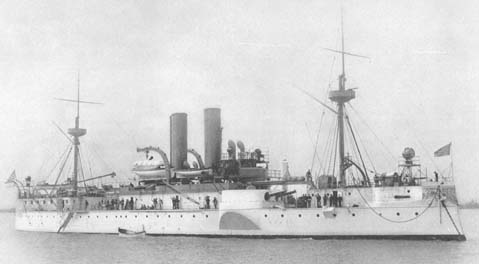
The battleship USS Maine
THE SPANISH-AMERICAN WAR - El Caney and Santiago
The approach of the war with Spain in 1898
found the 22nd Infantry in ideal condition for taking the field
against an enemy.
Like all other regular regiments of this period, the 22nd had
been brought to a high state of efficiency
both in respect to organization and equipment. Its effective
strength at the beginning of the war was thirty-five officers and
five hundred and nine enlisted men.
Most of the non-commissioned officers and many of the privates
were men of long service—the regular troops,
organized into the 5th army corps and constituting almost
entirely the force sent against the Spanish forces at Santiago,
Cuba,
formed the finest and the most effective army of its size ever
organized into one command.
With the news, on February 23, 1898, of the destruction of the
battleship Maine in Havana harbor,
came the settled belief that war with Spain was inevitable.
Preparations were quietly begun and on Saturday evening, April
15,
definite instructions were received relative to the movement of
the regiment closer to the field of active operations.
April 18, in compliance with orders from Headquarters, Department
of the Missouri, dated April 15, the regiment entrained at Fort
Crook
for Mobile, Alabama. Twenty-nine officers * and four hundred and
eighty enlisted men constituted the command.
That the people were solidly behind the approaching war was
continuously evidenced during the journey to Mobile.
At every stop enthusiastic citizens greeted the regiment with
brass bands and cheers. The entry into the Southern States
was like a triumphal procession. The train was loaded with
flowers and the engine was almost hidden under banks of blossoms.
* Colonel C. A. Wikoff, commanding regiment;
Lieutenant Colonel J. H. Patterson, Major W. M. Van Home,
1st Lieutenant Herman Hall, adjutant; 1st Lieutenant J. F. Kreps,
quartermaster; Chaplain E. H. FitzGerald. regimental chaplain;
Captains B. C. Lockwood, W. H. Kell, Theodore Mosher A. C.
Sharpe, J. J. Crittenden, R. N. Getty, and F. B. Jones;
1st Lieutenants E. O. C. Ord, H. C. Hodges, Jr., G. H. Patten, T.
W. Moore, W. M. Swaine, G. J. Godfrey, W. L. Taylor, and H. L.
Jackson;
2nd Lieutenants A. C. Dalton, W. H. Wassell, P. W. Davison, O. R.
Wolfe, Harry Clement, D. S. Stanley, Jr., Isaac Newell, and F. W.
Lewis.
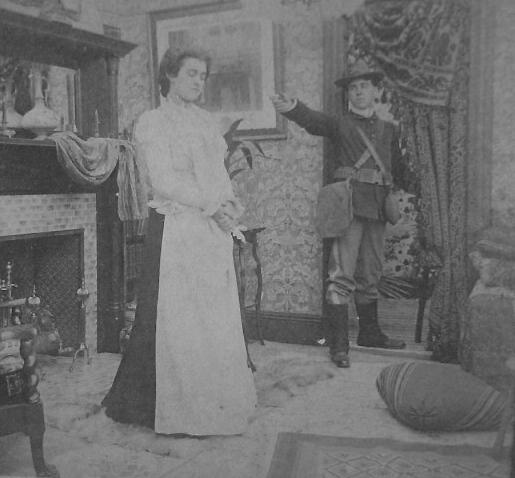
A Soldier saying goodbye to his wife as
he leaves for war.
Such staged, emotional, patriotic themes in photos were very
popular in 1898.
The regiment went into camp near
Mobile April 20. |
From a stereoview entitled: |
May 4, 1st Lieutenant Wilson Chase joined the
regiment from detached service on college duty.
On May 6, the regiment was transferred to the 1st Brigade,
Infantry Division.
May 14, 1st Lieutenant H. C. Hodges, Jr., left the regiment on
special recruiting duty at Fort McPherson, Ga.
May 23, 2nd Lieutenant D. L. Stone, recently graduated from West
Point, joined the regiment.
On May 25, the regiment was finally assigned to the 1st Brigade,
2nd Division, 5th Army Corps.
May 26, Captain A. C. Sharpe left the regiment on detached
service as adjutant general, 1st division, 5th army corps.
June 1st, Captain W. H. Kell left the regiment
on detached service as adjutant general, 1st brigade, 2nd
division, 5th army corps.
June 3, 2nd Lieutenant P. W. Davison was detailed brigade
commissary, 1st brigade, 2nd division, 5th army corps.
Lieut. Davison remained on duty with troops throughout the
campaign.
June 7, the regiment broke camp and proceeded
by rail to Port Tampa, Florida, arriving there at 1 p. m.
The same night it went aboard the transport Orizaba, No.
24. The Orizaba dropped anchor in the bay and remained
there until 8 A. M.,
June 14, when the 5th Army Corps started on its expedition
against Santiago de Cuba. At this period the enlisted strength of
the regiment
had been reduced to four hundred and sixty-nine, by reason of
discharges and details of various nature.
Santiago had been made the objective of the expedition because of
the fact that the Spanish fleet had been blockaded in the harbor
there,
and its capture or destruction necessitated the assistance of an
army.
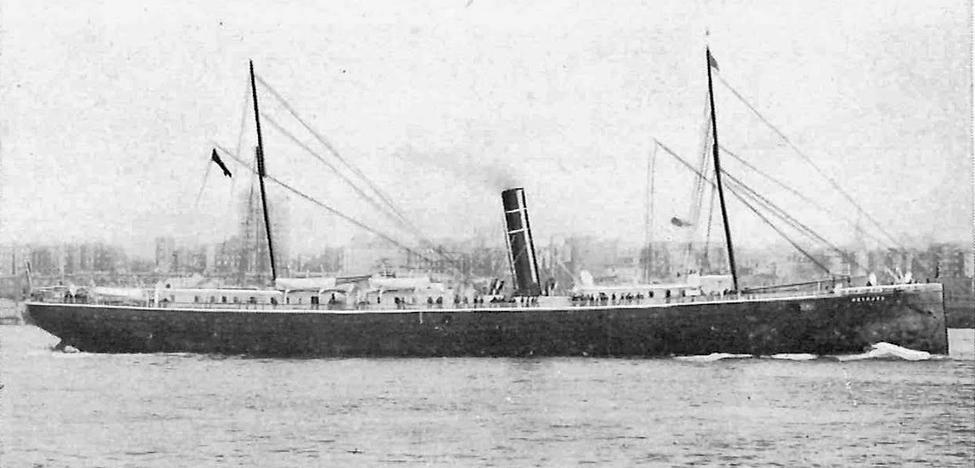
The Transport Orizaba which brought
the 22nd Infantry to Cuba
The ship was 336 ft long and had a displacement of 3496 gross
tons.
For the invasion of Cuba, she carried the following consisting of
35 officers and 622 enlisted men:
2nd Massachusetts Volunteer Infantry (one battalion)
22nd U.S. Infantry from Tampa to Cuba.
4th U.S. Artillery, Batteries G and H (Siege Artillery battalion)
Photo from the Stillwater Woods webpage
June 20, Colonel Wikoff was placed in command
of the 3rd Brigade, 1st Division, 5th Army Corps,
and Lieutenant-Colonel Patterson took command of the regiment.
1st Lieutenant Wilson Chase was detached from the Regiment
and accompanied Colonel Wikoff as his aide. (Ed., Colonel Wikoff,
in his capacity as Brigade Commander, was, however,
still a Colonel of the 22nd Infantry, and still officially the
22nd Infantry Regimental Commander.)
The expedition arrived off Morro Castle, at the
harbor entrance to Santiago, about noon June 20. The 2nd
Division, 5th Army Corps,
was ordered to disembark first, accompanied by the Gatling gun
detachment.
The steep and rocky coast of Cuba in the
vicinity of Santiago bay offers no good landing place.
An iron pier used for unloading ore at Daquiri, the point
selected for disembarkation, offered but slight aid in the way of
a landing place.
This pier the Spaniards had unsuccessfully attempted to destroy
by fire.
Early in the morning of the 22nd, the regiment was transferred to
small boats and towed toward the smoldering dock.
Then men showed characteristic American dash and desire for
action. As the men were unloaded from the Orizaba,
cheers burst from the decks of the nearby transports awaiting
orders to debark. Regimental bands played and shells screeched
overhead,
bursting far up on the heights as the fleet out at sea bombarded
the wooded mountains that rise from the beach.
Tugging launches puffed and whistled their way toward shore. Near
the ore pier a wall of surf roared an angry welcome
and broke into swamping torrents. Boat bumped boat as they
crowded toward the dock and were swept against the piles,
bobbing here and there until caught by a line from the land. Out
scrambled the regiment, tossing blanket rolls ahead of them,
but carefully handing rifles to helping comrades—a
surf-drenched, panting regiment, that caught its breath again
and cheered as their colors unfurled—the first on Cuban
shore.
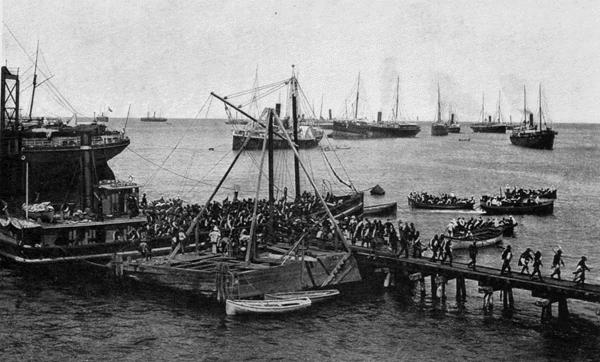
The iron ore pier at Daiquiri, the 2nd
day of the landings,
when the sea had calmed and the troops coming ashore had an
easier time.
After a brief rest the regiment marched inland
about four miles on the road to Siboney and camped on Daquiri
creek.
June 23, the regiment was placed in advance and by noon had taken
possession of Siboney,
the Spanish force of six hundred retiring and offering no
resistance. Here the first Spanish colors taken in the campaign
were captured by men from Company B (Crittenden's) after the town
had been entered.
In Siboney the next day,
Orrin R. Wolfe of the Twenty-second Infantry found about half a
dozen locomotives in a roundhouse.
The Spanish had tried to sabotage them by destroying a vital
part, such as a driving rod, from each of them. "I knew I
had
a number of men in the company who had been railroad men,"
Wolfe reminisced. "We worked for some time, taking a part
from one engine
and putting it in the place of a part that was missing. One was
ready to go about 3:00 P.M. We only had a little water, but a
water tank
was about 200 yards down the road, so we had up steam. I was in
the cab with three or four soldiers, one acting as engineer.
I got hold of the whistle cord and proceeded to toot. We ran out
of round-house and down the track, soldiers cheering." ¹
The regiment was ordered in from outpost on
June 24, and sent to reinforce Young's brigade engaged at Las
Guasimas, four miles distant,
but did not arrive until after the action. It camped that night
near Sevilla in advance of the morning's battlefield.
The regiment moved to Sevilla on the 25th and remained in camp
there until the morning of the 27th, when it moved forward
four miles on the road to Santiago. It remained in this position
until June 30, parts of the companies on outpost at all times. '
The march toward Santiago was resumed at 4 P. M., June 30, and
that night the regiment bivouacked along the Caney road,
east of the town and in sight of the Spanish outposts.
The general plan of the Santiago campaign was to send one
division (Lawton's) against Caney; after taking the town
the division to swing to the southwest and take position on the
right of the line (two divisions) in front of Santiago.
As part of the 1st Brigade of Lawton's division the 22nd Infantry
was to occupy the roads leading from Caney to Santiago,
and cut off the Caney garrison should it attempt to escape,
At 4:30 A. M., July 1, the twenty-four officers and four hundred
and thirty-six enlisted men comprising the 22nd Infantry
marched down a trail overgrown with brush and vines until it
reached the main Santiago-Caney road near the Ducoureaux
house—
covering this road was a part of the regiment's assigned
position. The 2nd Battalion was then deployed and skirmished
northward
through the jungle to see if there were any other roads over
which the Spaniards could retreat to Santiago.
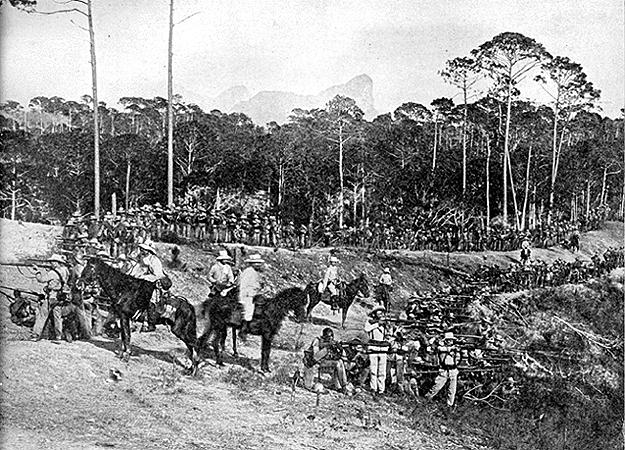
A Spanish infantry unit assumes a
defensive formation
as it moves down a Cuban road.
Meanwhile, the 1st Battalion moved rapidly
northward along the main road, until at about 1,200 yards the
advance guard, Company A,
received a sharp Mauser fire from the town. The battalion then
deployed east and west of the road. Lieutenant-Colonel Patterson,
who accompanied the 1st Battalion was severely wounded here and
Major Van Horne took command of the regiment.
For half an hour the advance was through dense undergrowth and
tangled vegetation
that prevented the battalion from seeing more than ten feet to
the front.
To keep the line the men were obliged to continually call to the
skirmishers on either side of them.
The Spanish fire, coming from a chain of intrenched blockhouses
and almost invisible rifle pits, swept the ground.
At 800 yards a clearing was reached, beyond which the battalion
caught its first glimpse of the enemy's position.
The men were ordered to lie down and take such cover as the
ground afforded.
Volleys by company and platoon were fired during the brief
moments when the enemy exposed themselves.
To husband ammunition, sharpshooters determined the range by
actual firing before volleys were fired.
General Ludlow, Brigade Commander, took position with Company A
at this period of the fighting
and from this point issued his orders during the remainder of the
day.
The battalion was advanced to 700 yards with severe losses. For
three hours it had been under heavy fire from an intrenched
and skillful enemy that had made elaborate plans to beat back an
attack from this very direction.
Meanwhile, the second battalion, the extreme
left of the line, slowly forced its way through the underbrush
for half a mile,
swung to the east, and under heavy fire from the then concealed
positions, laboriously hacked its way through the chaparral
until it found the Cuabietas road leading westward from the fated
village. Part of the regiment's assigned position was the
covering of this road.
So difficult was the advance that it was impossible to keep the
line together. Company F (Getty's) became separated
from the rest of the battalion. This company reconnoitered the
ground west of the battalion's position and after receiving the
enemy's fire
from the San Miguel blockhouse without replying to it, rejoined
the battalion at the edge of a fire-swept clearing
500 yards from the enemy's main position. As a result of this
reconnoitering, Captain Getty succeeded in cutting the Caney
telephone line
along the Cuabietas road. From noon until one o'clock there was a
lull in the firing.
Taking advantage of it, General Ludlow moved the second battalion
still farther to the west and north, advanced the first battalion
to within 500 yards of the enemy, and placed the 8th Infantry
between the first and second battalions of the 22nd Infantry.
After one o'clock the enemy renewed its fire with increased vigor
and the men of the command were compelled to hug the ground
at the edge of the clearing and watch for the scarce moments when
the enemy would expose themselves.
The heat was almost insufferable, water was almost impossible to
obtain. Any movement along the line was sure to bring a
well-directed volley
from soldiers who were veterans in bush warfare. Men lay
sweltering on the ground waiting for something to shoot at;
bullets ploughed the ground in front and threw dirt over their
sweaty faces. The regiment prayed for something more
than momentary shots at the enemy. Finally the regiment located
the intrenched blockhouses and rifle pits south of the village.
These defenses had been constructed and placed by a master hand;
they afforded the defenders almost perfect protection
and the enemy was able to sweep with their fire all parts of the
regiment's position.
Loopholes in the blockhouses and parapets of the trenches were so
sloped that unaimed fire covered the field.
From these loopholes, at short intervals came puffs of smoke and
then a hail of bullets. Occasionally the defenders stood upright
in the trenches
to fire volleys and for a brief interval the parapet appeared
dotted with straw hats. A moment later the enemy was once more
invisible.
At times a Spaniard would dart from trench to blockhouse.
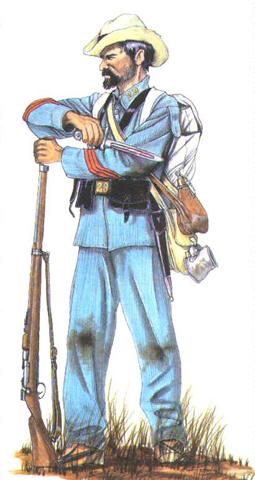
Spanish soldier of the 29th Regular
Infantry Battalion.
514 soldiers of the 29th fought a tenacious defense at El Caney,
and only retreated when their ammunition ran out.
Late in the afternoon when the town was
captured, the enemy trenches were found filled with dead and
wounded.
Despite difficulties of target, the regiment shot accurately.
From due south of the town came enemy fire that remained
unanswered. Tall trees in this direction concealed the main
buildings
of the town and field glasses could discover no enemy. To return
this fire by infantry would have been a waste of ammunition.
The artillery seemed to have no effect on this position so far as
stopping the enemy's fire from this direction.
Capron's battery changed position about 2:30 o'clock and fired a
few shots at the defenses south of the town
but produced not the slightest diminution in the fire coming from
the works there.
Heat, thirst, inability to see the enemy, absolute ignorance in
regard to the damage inflicted on the Spaniards
and visible evidence of our own losses produced some
discouragement and an intense desire to meet the enemy at close
quarters.
Orders to charge the town would have met with enthusiastic
response, but the plan of battle required the regiment
to hold its exposed position covering the two roads to Santiago.
Suddenly from the stone fort east of the village came the sound
of American cheers.
The stone fort, its intrenchments cut in solid rock, had fallen.
Gallant troops, gallantly led, had cut through wire
entanglements,
charged up the hill and stormed the fort. The flag of the United
States now appeared where all morning had waved the Spanish
colors.
It was then three o'clock in the afternoon.
The larger garrison stubbornly remained in the village for an
hour and a half longer and held some of the other defensive
works,
but finally, under the destructive fire of Ludlow's brigade, was
forced to evacuate its position.
The Spaniards attempted a retreat to Santiago, choosing the
Cuabietas road. But this road was barred by the 2nd battalion of
the 22nd—
a battalion that with patience and persistence had lain all day
under heavy fire waiting for this moment.
The retreating Spaniards were met with company volleys. Quickly
the retreat was changed to a rout and the rout to a surrender.
Sixty-five prisoners and a quantity of arms and ammunition were
taken by Companies D and F.
Few, if any, of the retreating force escaped. Along the line of
their march were 186 dead and wounded,
among them the former gallant defender of Caney, General Vera del
Rey.
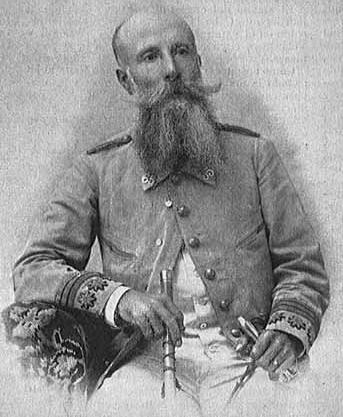 -----------------------------------
-----------------------------------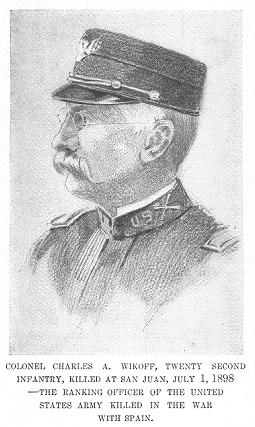
General Joaquin Vara del Rey Y Rubio, Commander of the Spanish at El Caney ---------------------------COL Charles Wikoff-----------------
The battle was won—but the victors had
suffered severe losses. Of the twenty-four officers of the
regiment who participated in the battle,
six had been wounded ** ; of four hundred and thirty-six enlisted
men, forty-four had been killed and wounded.*** The total loss
was nearly eleven per cent.
San Juan, too, was marked with the regiment's blood: Colonel
Wikoff was killed early in the day, while gallantly
superintending the deployment of his brigade.
** Lieutenant Colonel John H. Patterson,
Captain Theodore Mosher, Captain John J. Crittenden, Captain
Frank B. Jones,
1st Lieutenant George J. Godfrey, 2nd Lieutenant William H.
Wassell.
*** Killed:
Private Samuel Bennet, company A;
Privates Michael Gibney and Michael Werner, company B;
Private James W. Bampton, company C;
Private Gustav V. Sutter, company E;
Corporal Gebhard Young and Private Willie Brooks, company G;
Privates William L. Forrester and Peter Johnson, company H.
Wounded:
Corporal Laurence Graebing and Privates Robert
M. F. Ellingham, Henry J. Pohl, Charles A. Pound,
William Mendel, Michael Sheehy, and Gottfried Wruck, company A;
Corporal Hannan E. Newman, Musician David Olson, Wagoner Frank
Kohlert, Privates John H. Grotness and Joseph Schmitt, company B;
Sergeant Henry Janz and Private John C. F. Hill, company C;
Privates James Connaghan and George Hoover, company D;
Privates Lyndall C. Jamison, Frank W. Nelson, and George Winters,
company E;
Sergeant William Parnell, Privates Albert Field, Fred W. Lynch,
and Alet B. Strock, company F;
Sergeant John B. Senecal, Corporal Christian P. Nielsen, Wagoner
Fred Miller, Privates Elmer E. Sedam,
Casper Meither, Charles A. Osgood, and Delbert E. Hartzell,
company G;
Privates Michael A. Donohoe, James Harris, Leonard Kupfer, and
Richard Shepard, company H.
Care of the dead and wounded—our own and
those of the enemy—next demanded attention. Our dead were
buried on the field.
The wounded were carried back to a partially sheltered spot
beneath the trees where the brigade hospital had been located.
In the enemy's positions were ample proofs of the stubbornness of
their defense and the accuracy of our fire.
In one small trench were counted thirty-seven dead Spaniards.
At six o'clock in the evening, orders were received to march back
to the Ducoureaux house and thence to Santiago.
The regiment slept along the road, many without blanket rolls,
all without rations.
**********************
¹ The
Splendid Little War by Frank Freidel
Burford Books, Inc. NJ 1958
Much of the above narrative taken from the 1904 and 1922 Regimental Histories
Additional information taken from:
Returns from Regular Army Infantry
Regiments, June 1821–December 1916. NARA
microfilm publication M665
National Archives and Records Administration, Washington, D.C.
Register of Enlistments in the U.S. Army, 1798-1914; (National Archives Microfilm Publication M233
Home | Photos | Battles & History | Current |
Rosters & Reports | Medal of Honor | Killed
in Action |
Personnel Locator | Commanders | Station
List | Campaigns |
Honors | Insignia & Memorabilia | 4-42
Artillery | Taps |
What's New | Editorial | Links |